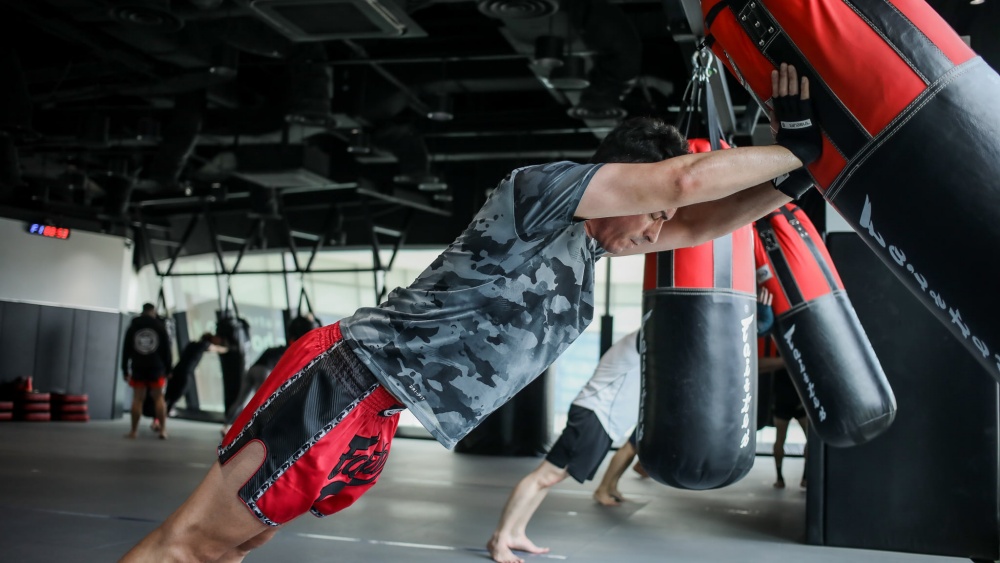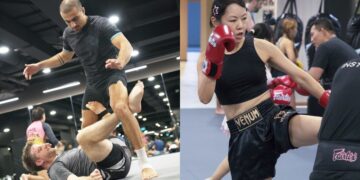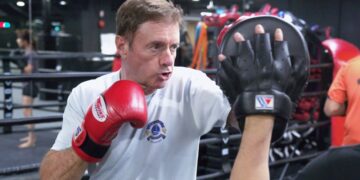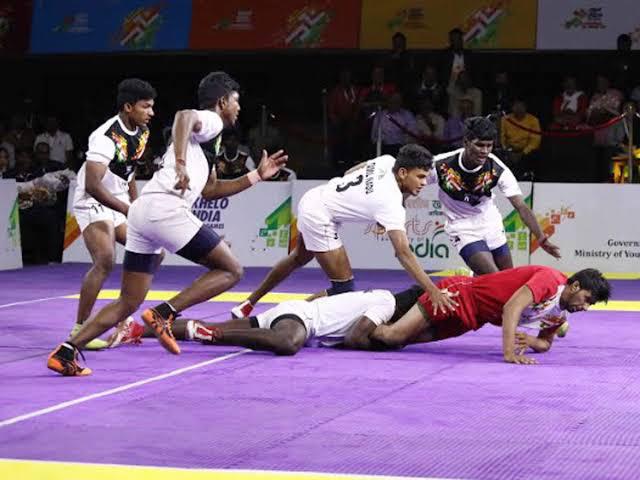
Your isometric strength plays a role in martial arts like Brazilian Jiu-Jitsu, Wrestling, Boxing, and Muay Thai, whether you realize this or not. Anything that requires holding a position while fighting against tension and other forces uses isometric strength. This means that many martial arts techniques, such as applying top pressure on opponents while grappling, use isometric strength.
Isometric training builds strength in ways that dynamic movements can’t. While dynamic exercises also help to build sports-specific strength, isometric training is equally important.
Why Fighters Should Care About Isometric Strength
Isometric training has many applications in fighting. Whether resisting a submission, holding a dominant position on the ground, or keeping an opponent trapped in a clinch, isometric strength keeps you in control.
Isometric training involves contracting your muscles without changing their length. Think of exercises like the plank or wall sit, which make your muscles burn like crazy without having to shorten and lengthen them as you do during dynamic exercises.
Some of the benefits isometric training brings fighters include:
1) Unrelenting Grip Strength
Grip strength and endurance play a considerable role in martial arts like BJJ, where hand or sleeve control can be the difference between successfully executing a technique or ending up in a disadvantageous position. Grip strength also plays a role in striking-based martial arts like Muay Thai in clinched positions.
Exercises like towel hangs, farmer’s carries, and plate pinches are effective isometric exercises for increasing grip strength.
2) Improved Core Stability
A strong core does more than make you look good; it increases your ability to resist forces. Core stability is crucial for many aspects of fighting, such as scrambling for positions, absorbing strikes, and defending against takedowns.
Isometric exercises like planks, hollow holds, and hanging leg raises are excellent ways to strengthen your core.
3) More Explosive Strikes
Isometric training helps increase explosive power, despite how counterintuitive that might seem. Holding a position under tension builds muscle strength at specific angles, which can translate into more force behind strikes and takedowns.
Boxing instructors often stress the importance of isometric training, which strengthens the stabilizer muscles needed for rapid, powerful movements.
4) Endurance For Long Rounds
Muscle endurance is just as important as muscle strength for fighters since fighting requires you to maintain your output for specified lengths of time, typically broken into rounds. Fatigue is the worst thing that can happen during a fight since it leaves you at your opponent’s mercy.
Isometric training helps improve muscle endurance by delaying fatigue. Exercises like entering a squat against a cage as you wall walk or trying to finish an arm triangle rely on sustained strength.
5) Injury Prevention
Isometric training strengthens the ligaments and tendons that hold your body together, reducing your risk of injury. Stronger corrective tissues mean your joints handle the stress put on them during training better, especially when performing intense physical activities. Isometric training also provides an alternate way to train your muscles if injuries have limited your mobility.
6) Improved Mind-Muscle Connection
Isometric training requires you to focus on engaging specific muscles, strengthening your mind-muscle connection. This heightened level of awareness leads to improved technique, balance, and coordination, key attributes for all fighters to develop.
7) Increased Resilience Under Pressure
Fighting is as mental as it is physical. It requires you to push through challenging situations as you try to carve a path to victory. Holding a difficult position similarly challenges your mental toughness. For example, how long you can hold a wall sit doesn’t depend only on how strong your legs are; your willingness to hold the position regardless of how much your legs burn also plays a role.
Isometric Training For BJJ, Wrestling, And Striking
Now that we’ve covered the basics of isometric training, let’s discuss how to make it a part of your training routine:
Brazilian Jiu-Jitsu (BJJ)
Some of the best isometric exercises to build sport-specific strength for BJJ include:
- Planks: Planks and variations of the exercise help to build core strength that translates into ground fighting.
- Wall sits: This exercise engages muscles in your legs similarly to how they are engaged when you’re trying to keep an opponent in your guard.
- Grip Hangs: Here’s an excellent way to improve your grip strength for BJJ. It’ll considerably improve your ability to finish techniques like Ezekiel chokes.
- Isometric Pulls: Pulling against immovable objects like a sturdy pole engages your muscles similarly to how they’re engaged when you resist an opponent’s movement.
- Triangle Choke Holds: Strengthen your legs and hip flexors by locking triangle chokes for as long as possible on training dummies. This will improve your ability to squeeze for longer periods when trying to finish the choke on real opponents.
Wrestling
Some isometric exercises wrestlers should consider adding to their training routines include:
- Bridge Holds: This exercise helps strengthen your neck and posterior chain, strengthening many of the muscles engaged when defending against takedowns.
- Static Squat Holds: This exercise helps strengthen the muscles in your legs, allowing you to maintain strong stances for longer.
- Farmer’s Carries: Farmer’s carries help with grip and core strength, improving your ability to control opponents in clinch positions.
- Neck Isometrics: These exercises strengthen your neck, helping you to absorb the impact of slams.
Striking-Based Martial Arts
- Isometric Punch Holds: Throw a punch and hold the position to build endurance in your shoulders.
- Wall Pushes: Push on a wall to increase your ability to push opponents off you.
- Calf Raise Holds: This exercise helps to improve your balance and build muscle endurance in your lower leg.
- Trap Bar Deadlift Holds: This exercise strengthens muscles in your posterior chain, increasing the explosive energy in your strikes.
Give Isometric Training a Try
Isometric training strengthens your body in ways dynamic exercises can’t, increasing your abilities as a fighter. Swap some dynamic exercises for isometric ones and watch how much stronger you become.
You may also like:
Should Martial Artists Run? The Pros And Cons Of Roadwork
Combat sports demand a fluid synergy of raw power, speed, mobility, balance, and agility. Animal movements are one of many ways fighters can strengthen their bodies to perform optimally. These exercises involve mimicking the movements…
Running has historically been a considerable portion of many martial arts fighters’ training regimens, but it’s not the only way to get your heart pumping and build up your cardiovascular endurance. Many non-traditional workouts challenge…
High-intensity training is one of the best and most effective ways to reach your fitness goals, whether for general health or conditioning as a martial artist. It helps push your mind and body to the…
Juggling work obligations, family responsibilities, and martial arts training can be challenging. Micro workouts are one of the ways people with busy schedules keep their bodies in excellent shape without spending hours at the gym….
Figuring out if your workouts should consist mainly of hypertrophy or strength exercises comes down to your fitness goals. Are you there to get bigger or stronger? Hypertrophy training is what you need to build…
A solid core serves as the foundation that enables martial artists to execute various techniques in these ancient styles. Your core is the group of muscles in your hips and midsection that surround your spine,…
Getting older doesn’t mean you have to hang up your gloves or retire your Gi in martial arts. While aging is inevitable, there are ways to keep dominating the mat, ring, and cage as your…
As children grow, developing life skills like emotional resilience is essential to help them navigate life’s challenges. While these skills can be learned through experience and guidance, activities like martial arts offer a powerful and…
The focus, strategy, and grit you learn while training martial arts like Muay Thai, Brazilian Jiu-Jitsu (BJJ), and Boxing carry over into your professional life when deadlines are looming, co-workers call in sick, and your…
Brazilian Jiu-Jitsu is a martial art that offers many ways to finish a match. A common yet practical way to do this is to attack the opponent’s arm with a variety of arm locks. In…
You’ve tried every diet there is out there: keto to force your body to use fat as its primary source of energy, intermittent fasting to improve testosterone production, even that questionable “caveman” phase where you…
Everyone has a natural fighting style. Some instinctively look to bombard opponents with volume, while others prefer a more cautious approach. Some people feel more comfortable throwing strikes at attackers, while others prefer to wrestle…





![[WATCH] IND vs SA 2025: Umpire Rohan Pandit down in pain as Sanju Samson drive hits knee](https://www.babu88sports.com/wp-content/uploads/2025/12/watch-ind-vs-sa-2025-umpire-rohan-pandit-down-in-pain-as-sanju-samson-drive-hits-knee-360x180.jpg)





























